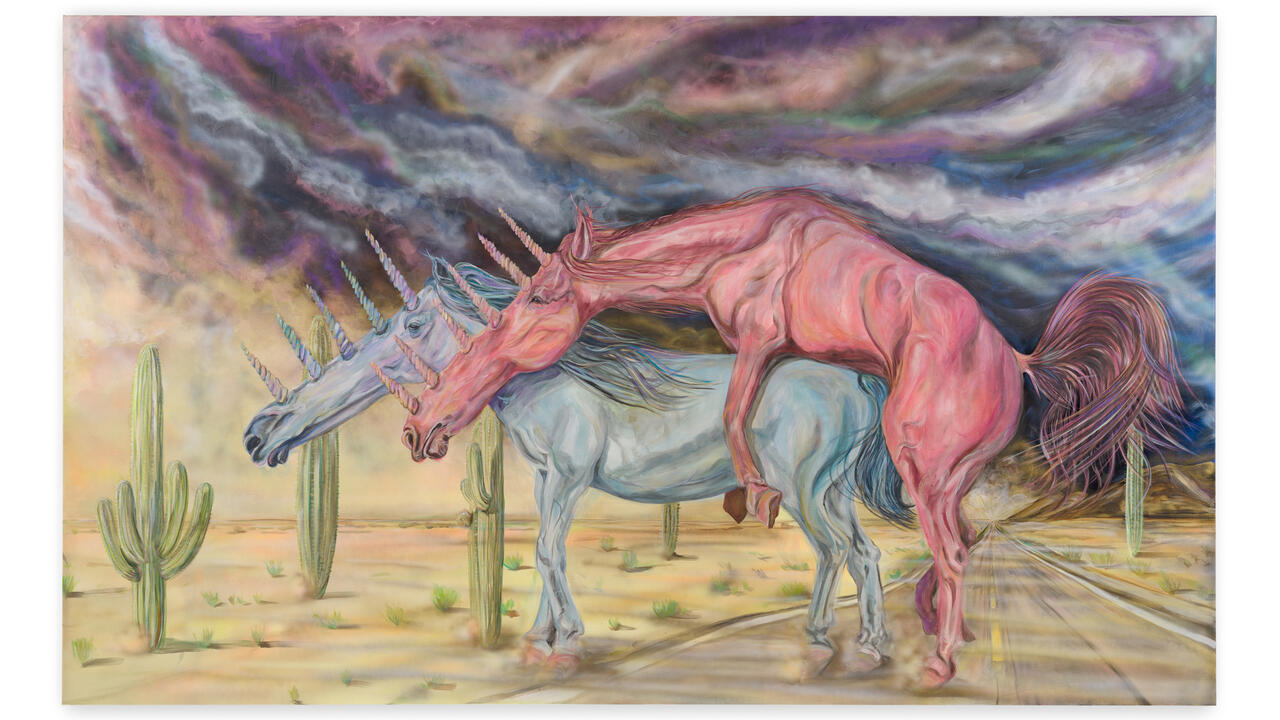How Jana Euler’s Phallic Sharks Are Waging War on Art-World Disparity
The triumphant virtuosity of Euler’s latest paintings at Berlin’s Galerie Neu
The triumphant virtuosity of Euler’s latest paintings at Berlin’s Galerie Neu

‘I think there is nothing in these paintings you would not see or miss, if left undescribed,’ notes Jana Euler in the press release for her third show at Berlin’s Galerie Neu. Indeed, the eight works in this series, each showing a shark leaping vertically out of the water, leave little to the imagination in their overtly phallic depictions. Under the title ‘Great White Fear’, they offer an apparently ridiculous answer to what remains a ridiculous situation: gender disparity in general, and in the art world in particular, especially within the terrain of painting. The show opened during Berlin’s annual Gallery Weekend, where 73 percent of the participating galleries hosted solo shows by white men, and a few weeks after Stuttgart’s Staatsgalerie offered up an exhibition of early works by George Baselitz, Anselm Kiefer, Sigmar Polke and Gerhard Richter, as cornerstones of an a-political resurgence of ‘Urdeutsches’ (Ur-German) art. This is the landscape in which Euler’s paintings are situated.

Painting, particularly in Germany, is ‘occupied territory’, as artist Monika Baer once remarked, ‘which leaves it open to takeovers’. In both subject and style, Euler’s ‘Great White Fear’ is just such a takeover. When Euler began her first shark painting in August 2018 (GWF 1, all works 2019), #MeToo was in the air and, with it, the first tremors threatening to dislodge the vast plateaus of white male privilege. Euler’s sharks are not muscular creatures gliding with silent menace through the waters, however. They thrust up awkwardly into the air exposing tender bellies, mouthfuls of uneven teeth and pained expressions. The sheer verticality of their composition and scale (at three by two metres each, her largest works to date) leads these ungainly effigies to peer down at their audience from extreme angles.

The series performs a chronological narrative of self-conscious painterly virtuosity. The thick oil impasto of the first work modulates to a smoothly pale and dirty Luc Tuymans-esque sheen in the second. The shark itself becomes an increasingly veiny and phallic protuberance. By GWF 4, the artist’s own features have been added to its face; a self-portrait with bulging eyes and flaring nostrils, like a crudely unflattering selfie. GWF 5 takes a Jackson Pollock turn, as the shark crashes turbulently out of the water, in a shower of ejaculatory splashes and calligraphic squiggles. GWF 6 is pin-up-like, with its air-brushed sun-spot glare and an increasingly weak-chinned expression. As the motif takes on stock-photo recognizability, we are asked instead to look at the paint and consider the artist’s skill. These tactics are familiar from Martin Kippenberger’s approach: both the efficacy of the series as a foil for voracious expression, and the subversive strategy of simultaneously occupying and deriding the act of painting and its historic traditions. Irony and seriousness fold into each other in layers of mutual reinforcement.

Euler’s paintings traffic in the grotesque, something increasingly present in our daily politics and social-media cycles. They seem to present the last gasps of a species living off its own notoriety, but undercut by a creeping sense of fear and vulnerability. ‘The monstrous figure truly becomes an erotic ornament,’ as Mike Kelley had it in his definition of the grotesque.
Euler’s exhibitions ask how an artist’s work can inhabit art’s structures – the commercial gallery, the market, the tradition of painting – while articulating criticism from within. They are as much concerned with social reception and the mechanics of interpretation, as with the medium itself. This time it’s fear’s turn to take centre stage: ‘Who is afraid of what?’ Euler asks. ‘What is afraid of whom?’ Playing out in the sexualized social field that is the art world, these new works give hilariously concrete form to its underlying disparities.
Jana Euler, ‘Great White Fear’ was on view at Galerie Neu, Berlin, Germany, from 26 April to 30 May 2019.
Main image: Jana Euler, ‘Great White Fear’, 2019, exhibition view. Courtesy: the artist and Galerie Neu, Berlin; photograph: Stefan Korte






















